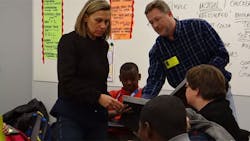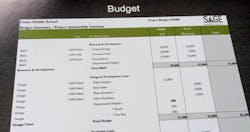Getting Kids Interested in Manufacturing Careers
Read any industry piece on workforce development and the apparent challenges of filling the skills gap, and you’ll see experts stressing the importance of companies—especially in manufacturing and engineering—having hands-on involvement in their local education centers.
The logic behind this strategy is a sound one, suggesting that if companies can reach tomorrow’s workforce at an early age, they can open their minds to the world of advanced manufacturing and inspire them to take an educational path that will lead them to a successful career.
This strategy often focuses on the promotion of curriculums around science, technology, engineering, arts and math (STEAM) with the idea that manufacturers will work hand-in-hand with local schools to create engaging programs that offer real-world insight.
While just about everyone agrees with this concept, the reality is that very few are actually putting it into practice. Many manufacturers participate in career days or one-off showcases for students, but there is a lack of sustainable programs that are mutually beneficial (and enjoyable) for both sides.
In Greenville, S.C, Dr. Phinnize J. Fisher Middle School provides students with unique STEAM-based learning experiences that help put them in the right direction regarding career choices. Here’s a look at what they’re doing with real-world collaboration with companies in the area.
A Fresh Approach
This past school year, Fisher Middle School launched its mentor program to provide students with an opportunity to learn about a STEAM career that interests them. Twelve companies took part in the program, including Sage Automotive Interiors, Fluor, CU-ICAR, Michelin, Hubbell Lighting and others.
“We did research to see what other programs were out there and what was working,” says Matthew Critell, Program Director at Fisher Middle School. “We found that companies were eager to participate in these programs, but didn’t know how to do it. The traditional setting would be for them to come in for a day or a couple of hours, do a small project and then move on. Obviously, that doesn’t create the lasting impression needed to inspire. We realized we needed something different so rather that duplicating other programs, we built one from the ground up.”
Fisher Middle School’s mentor program kicked off in the fall with a mentor fair—similar to the format of a career fair—during which representatives from the participating companies had to work to “recruit” students from Fisher’s sixth grade class to select them as the company they wanted to work with.
Once the mentor groups were determined, Fisher Middle worked with the partnering companies to develop projects that would reflect real-world scenarios for their industry. The mentoring company met with their group of students four times during the academic year to work on the project.
Of critical importance was getting the students to understand the many different roles that come into play in modern manufacturing.
Here’s a sample project that Sage Automotive Interiors and students came up with together, to illustrate the various factors involved in automotive design:
The Project: Planning for Tomorrow’s Driver
The scenario presented to Fisher students was as follows:
The auto industry is constantly changing. To assist Sage Automotive in staying current with the needs of tomorrow’s drivers, it is looking to incorporate a younger generation into its workforce that can help them plan for the drivers of the future. There are many components to designing a car, and some of them are all done behind the scenes. Your team is expected to:
- Look at the characteristics of today’s automobile interiors. What features do you like and dislike? What advancements can be made to make the interiors more durable?
- Create a profile for your generation and imagine the look and design that your future self would like to see in an automobile. What type of fabric, colors, accents and customizable features would you like to see in the first car you drive?
- This job requires multiple teams to accomplish this project: Design Team, Research, Financial, and Management. Your job is to determine which role you want to play in this process.
Susan Mizelle, Business Manager at Sage Automotive Interiors, led the company’s mentor team in working with the students. They tasked the students with creating a profile and interior design to meet the needs of tomorrow’s drivers.
“We wanted to give students perspective on the various types of careers found in our industry so we broke the project down into different job functions, including research and design, finance and management,” says Mizelle. “Equally important was creating a project that forced these different groups to work together for one common goal.”
Students worked closely with the team at Sage to stay within a budget and develop materials the company often uses in its own designs, including “mood boards” which offered insight into the lifestyle of the target customer for their project cars. Working together, they eventually narrowed down their choice of fabric for each car’s interior, which Sage presented affixed to a car seat in the final session.
The Results
“The students were incredibly engaged throughout the entire process,” says Mizelle. “Going in, I’ll admit that we had some concerns about keeping the students interested, but I thought the participation was great. We had one student in our group whose father actually works in our manufacturing facility and he told us it was great to get a better understanding of what his dad does. Hearing that certainly reinforced the concept that we need to continue to look for new ways to get tomorrow’s workforce engaged now. It’s one thing to hear about a career choice, but nothing will ever compare to getting hands-on experience.”
“I think the reason this was such a success was because it was student-driven,” says Critell. The students chose who they wanted to work with, and where they wanted to take the project. At the same time, the companies “were heavily invested in the program.”
Learn more from Upstate SC Alliance about workforce development and educational centers.

